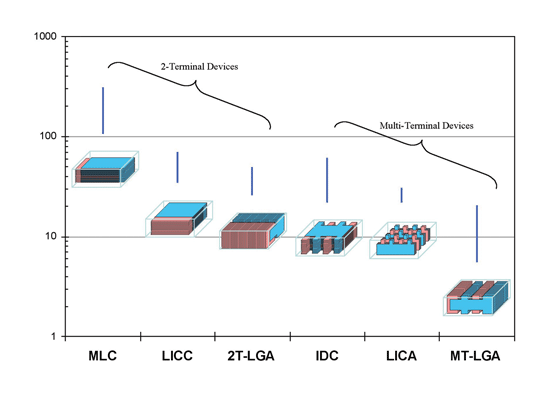Various capacitor types are competing as low-ESL solutions
BY TIM SULLIVAN
AVX
Myrtle Beach, SC
http://www.avxcorp.com
The rule of thumb to use a 0.1-µF capacitor on the power pin of a semiconductor device is rapidly fading away. Semiconductor products of today have multiple power pins and voltages. But, it is more than simply the additional power pins and multiple voltages making the old standard obsolete. The old rule is going away because the real characteristics of capacitors are influencing decoupling performance. A capacitor can be modeled as an R-L-C circuit.
With board-level operating frequencies exceeding the resonant frequencies of most MLCCs, parasitic inductances of capacitors are determining decoupling performance. The lower the equivalent series inductance (ESL) the better the decoupling performance of the capacitor above resonant frequency.
Decoupling schemes
Hardware designers now must allocate precious time to creating decoupling schemes. Decoupling design is complicated by the lack of specifics in semiconductor suppliers’ application notes.
Vague instructions in application notes include phrases such as “the designer needs to use a low-ESL capacitor for decoupling…” or “the design engineer must select a decoupling capacitor that can maintain the operating voltage of 1.2 V ±10%…” All designers can do is say thanks for the warning, but they are not told which capacitors feature low ESL values and how to design a decoupling scheme with them.
Decoupling architecture depends on circuit characteristics that include frequency, power, voltage, and capacitor technologies used. There are four low-ESL technology families of surface-mount ceramic capacitors for decoupling applications.
These families include low-inductance ceramic capacitors (LICCs), which are sometimes called RGCs, for reverse-geometry capacitors; inter-digitated capacitors (IDCs), land grid array (LGA) capacitors, and low-inductance capacitor arrays (LICAs) (see Fig. 1 ).

Fig. 1. A summary of the various solutions available for low-ESL designs includes LGA, IDC, and MLCC capacitors.
Before explaining the advantages of each technology, let’s take a closer look at factors that determine ESL performance.
ESL performance
ESL is based on two key fundamentals: the current loop through a capacitor, and how current paths within a capacitor interact. The smaller the current loop, the lower the capacitor’s ESL.
Capacitor designers have created architectures that steer opposing current paths near each other within a capacitor. These opposing currents interact to reduce the ESL. Therefore, differences between these four low ESL capacitor families are based on current paths and interactions between opposing current paths within each capacitor technology family.
MLCCs and LICCs
Standard SMT MLCCs have terminations on the shorter ends of the device and LICCs have terminations on the longer ends. Both capacitors use identical materials and internal structures. The lone difference is termination locations. A simple change in the location of terminations can reduce ESL by more then 75% by reducing the current loop.
These ESL figures are only for capacitors, not the entire decoupling architecture. Pad layouts, vias, and PCB materials determine system-level ESL and overall performance.
IDC technology
In the mid-1990’s, a new generation of low-ESL capacitors known as IDCs was introduced. IDC architecture combines the advantages of smaller current loops with the benefits of reduced inductance from opposing current loops.
The IDC structure has multiple interleaved terminations that are alternating power and ground connections. These opposing currents reduce the effective inductance of the capacitor. The most common IDC configuration is eight terminals arranged as four terminals on the long sides of a capacitor.
An 0306 IDC yields an ESL of 35 pH. This ESL performance is almost 70% less then an 0306 LICC. The 0306 IDC ESL performance is an order of magnitude better than the standard 0603 MLCC ESL of 450 pH.
LGA decoupling capacitors
The newest low-ESL decoupling capacitor family—known as LGA—was introduced in 2006. LGA architecture is a departure from standard MLCCs, LICCs, and IDCs.

A comparison of the internal structures of standard MLCC, IDC, and two-terminal LGA capacitors.
The electrodes within the LGA architecture are vertical and the spacing between terminations is smaller then any prior family of MLCC products. The LGA family includes products with two or more terminations. Initial LGA products are two-terminal devices that deliver ESL performance equal to eight-terminal IDCs.
These two-terminal devices are easier to layout and assemble versus IDCs. Watch for LGA devices with more than four terminals in 2008 that will set new standards for low-ESL decoupling capacitors.
LICAs: the oldest decouplers
The oldest low-ESL technology is a LICA. This technology was developed in the 1980s for use in high performance MCMs. Despite their age, LICAs are 4 x 4-array devices that deliver the lowest ESL performance of any production device.
Initial LICAs used C4 bumps to complement flip-chip semiconductor packaging. The original LICA used a unique dielectric developed to deliver maximum effective capacitance at high temperatures.
Today, LICAs are available in standard dielectrics along with standard Pb and Pb-free bumps. LICAs are the decoupling capacitor of choice for high-reliability space applications—such as the Mars Rover—and for large FPGAs in military applications.
EMI filters: an alternative
No review of decoupling would be complete without a look at some alternatives. EMI filters can be used for decoupling.
The most publicized EMI filters pushed for decoupling are X2Y. This technology effectively features two capacitors wired in parallel to create adjacent current paths that intersect orthogonally.
A substantial amount of potentially misleading marketing hype is circulating about the ESL performance of EMI filters. The bottom line is specific board layouts are needed to make an EMI filter function as a decoupling capacitor. EMI filters yield LICC-like performance at a price premium to LICCs. ■
Advertisement
Learn more about AVX





